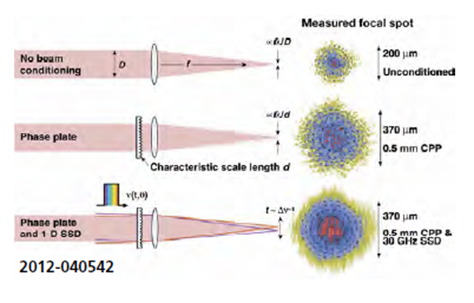As shown in Figure 4-11, focal spots produced by the CPPs still contain speckle with peaks ~10 times the average. Such high intensity speckles can increase the risk of laser–plasma instabilities. Further conditioning of the focal spot is achieved by causing the speckle pattern to change in time and time averaging of the varying speckle pattern to reduce the high intensity speckles. This is schematically illustrated in Figure 4-12. The time averaging is realized by the hydrodynamic or plasma processes in the target environment. The time variation of the focal plane speckle is achieved by a process known as smoothing by spectral dispersion (SSD). In SSD, a small amount of frequency modulated (FM) bandwidth is added to the laser, and this is angularly dispersed using a diffraction grating in the front end. The angularly dispersed frequencies lead to a spatial offsetting of the focal spot produced by the CPP. The time averaging of this dispersed spot then leads to a reduction of the focal plane contrast—often referred to as speckle averaging. On NIF, the FM bandwidth is applied using a 17 GHz frequency modulator in the MOR region. The minimum SSD bandwidth is restricted to 45 GHz at 1ω. If higher SSD bandwidths than 90 GHz are needed for a given experiment, this should be negotiated with the NIF operations team and expert groups.
Figure 4-12. Schematic illustration of how CPPs and 1-D smoothing by spectral dispersion achieve focal spot conditioning.





